Synthesis and Structural Characterization of Novel Urethane-Dimethacrylate Monomers with Two Quaternary Ammonium Groups Based on Cycloaliphatic Diisocyanates †
Abstract
1. Introduction
2. Materials and Methods
2.1. Materials
2.2. Synthesis of Monomers Possessing Quaternary Ammonium Groups
2.2.1. Synthesis of N,N-(2-hydroxyethyl)methylaminoethyl Methacrylate (HAMA)
2.2.2. Synthesis of 2-(Methacryloyloxy)ethyl-2-dodecylhydroxyethylmethylammonium Bromide (QAHAMA-12)
2.2.3. Synthesis of Quaternary Ammonium Urethane-Dimethacrylate Monomers (QA12 + IPDI and QA12 + CHMDI)
2.3. Nuclear Magnetic Resonance Spectroscopy (NMR)
2.4. Fourier Transform Infrared Spectroscopy (FTIR)
3. Results
3.1. 1H NMR
3.2. 13C NMR
3.3. FTIR Spectra
4. Discussion
5. Conclusions
Supplementary Materials
Author Contributions
Funding
Institutional Review Board Statement
Informed Consent Statement
Data Availability Statement
Conflicts of Interest
References
- Peutzfeldt, A. Resin composites in dentistry: The monomer systems. Eur. J. Oral Sci. 1997, 105, 97–116. [Google Scholar] [CrossRef]
- Gajewski, V.E.; Pfeifer, C.S.; Fróes-Salgado, N.R.; Boaro, L.C.; Braga, R.R. Monomers used in resin composites: Degree of conversion, mechanical properties and water sorption/solubility. Braz. Dent. J. 2012, 23, 508–514. [Google Scholar] [CrossRef]
- Pratap, B.; Gupta, R.K.; Bhardwaj, B.; Nag, M. Resin based restorative dental materials: Characteristics and future perspectives. Jpn. Dent. Sci. Rev. 2019, 55, 126–138. [Google Scholar] [CrossRef]
- Badr, S.; Abdulrahman, A.; Abdullah, A.; Essam, A.; Mohammad, Y.; Shahzeb, H. Effect of various antibacterial materials in dental composites: A systematic review. Ann. Dent. Spec. 2021, 9, 39–44. [Google Scholar]
- Ferrando-Magraner, E.; Bellot-Arcís, C.; Paredes-Gallardo, V.; Almerich-Silla, J.M.; García-Sanz, V.; Fernández-Alonso, M.; Montiel-Company, J.M. Antibacterial Properties of Nanoparticles in Dental Restorative Materials. A Systematic Review and Meta-Analysis. Medicina 2020, 56, 55. [Google Scholar] [CrossRef]
- Chan, D.; Hu, W.; Chung, K.; Larsen, R.; Jensen, S.; Cao, D.; Gaviria, L.; Ong, J.; Whang, K.; Eiampongpaiboon, T. Reactions: Antibacterial and bioactive dental restorative materials: Do they really work? Am. J. Dent. 2018, 15, 32B–36B. [Google Scholar]
- Chen, L.; Suh, B.; Yang, J. Antibacterial dental restorative materials: A review. Am. J. Dent. 2018, 31, 6B–12B. [Google Scholar] [PubMed]
- Farrugia, C.; Camilleri, J. Antimicrobial properties of conventional restorative filling materials and advances in antimicrobial properties of composite resins and glass ionomer cements—A literature review. Dent. Mater. 2015, 31, e89–e99. [Google Scholar] [CrossRef] [PubMed]
- Zhang, Y.; Chen, Y.; Hu, Y.; Huang, F.; Xiao, Y. Quaternary ammonium compounds in dental restorative materials. Dent. Mater. J. 2018, 37, 183–191. [Google Scholar] [CrossRef] [PubMed]
- Ramburrun, P.; Pringle, N.; Dube, A.; Adam, R.; D’Souza, S.; Aucamp, M. Recent Advances in the Development of Antimicrobial and Antifouling Biocompatible Materials for Dental Applications. Materials 2021, 14, 3167. [Google Scholar] [CrossRef] [PubMed]
- Imazato, S.; Chen, J.H.; Ma, S.; Izutani, N. Antibacterial resin monomers based on quaternary ammonium and their benefits in restorative dentistry. Jpn. Dent. Sci. Rev. 2012, 48, 115–125. [Google Scholar] [CrossRef]
- Huang, L.; Xiao, Y.H.; Xing, X.D.; Li, F.; Ma, S.; Qi, L.L.; Chen, J.H. Antibacterial Activity and Cytotoxicity of Two Novel Cross-Linking Antibacterial Monomers on Oral Pathogens. Arch. Oral Biol. 2011, 56, 367–373. [Google Scholar] [CrossRef] [PubMed]
- Manouchehri, F.; Sadeghi, B.; Najafi, F.; Mosslemin, M.H.; Niakan, M. Synthesis and Characterization of Novel Polymerizable Bis-Quaternary Ammonium Dimethacrylate Monomers with Antibacterial Activity as an Efficient Adhesive System for Dental Restoration. Polym. Bull. 2019, 76, 1295–1315. [Google Scholar] [CrossRef]
- Liang, X.; Huang, Q.; Liu, F.; He, J.; Lin, Z. Synthesis of Novel Antibacterial Monomers (UDMQA) and Their Potential Application in Dental Resin. J. Appl. Polym. Sci. 2013, 129, 3373–3381. [Google Scholar] [CrossRef]
- Makvandi, P.; Ghaemy, M.; Mohseni, M. Synthesis and Characterization of Photo-Curable Bis-Quaternary Ammonium Dimethacrylate with Antimicrobial Activity for Dental Restoration Materials. Eur. Polym. J. 2016, 74, 81–90. [Google Scholar] [CrossRef]
- Chrószcz, M.W.; Barszczewska-Rybarek, I.M. Synthesis and Characterization of Novel Quaternary Ammonium Urethane-Dimethacrylate Monomers—A Pilot Study. Int. J. Mol. Sci. 2021, 22, 8842. [Google Scholar] [CrossRef] [PubMed]
- Chrószcz-Porębska, M.; Kazek-Kęsik, A.; Chladek, G.; Barszczewska-Rybarek, I. Novel mechanically strong and antibacterial dimethacrylate copolymers based on quaternary ammonium urethane-dimethacrylate analogues. Dent. Mater. 2023, 39, 659–664. [Google Scholar] [CrossRef] [PubMed]
- Drejka, P.; Chrószcz-Porębska, M.; Kazek-Kęsik, A.; Chladek, G.; Barszczewska-Rybarek, I. Chemical Modification of Dental Dimethacrylate Copolymer with Tetramethylxylylene Diisocyanate-Based Quaternary Ammonium Urethane-Dimethacrylates—Physicochemical, Mechanical, and Antibacterial Properties. Materials 2024, 17, 298. [Google Scholar] [CrossRef] [PubMed]

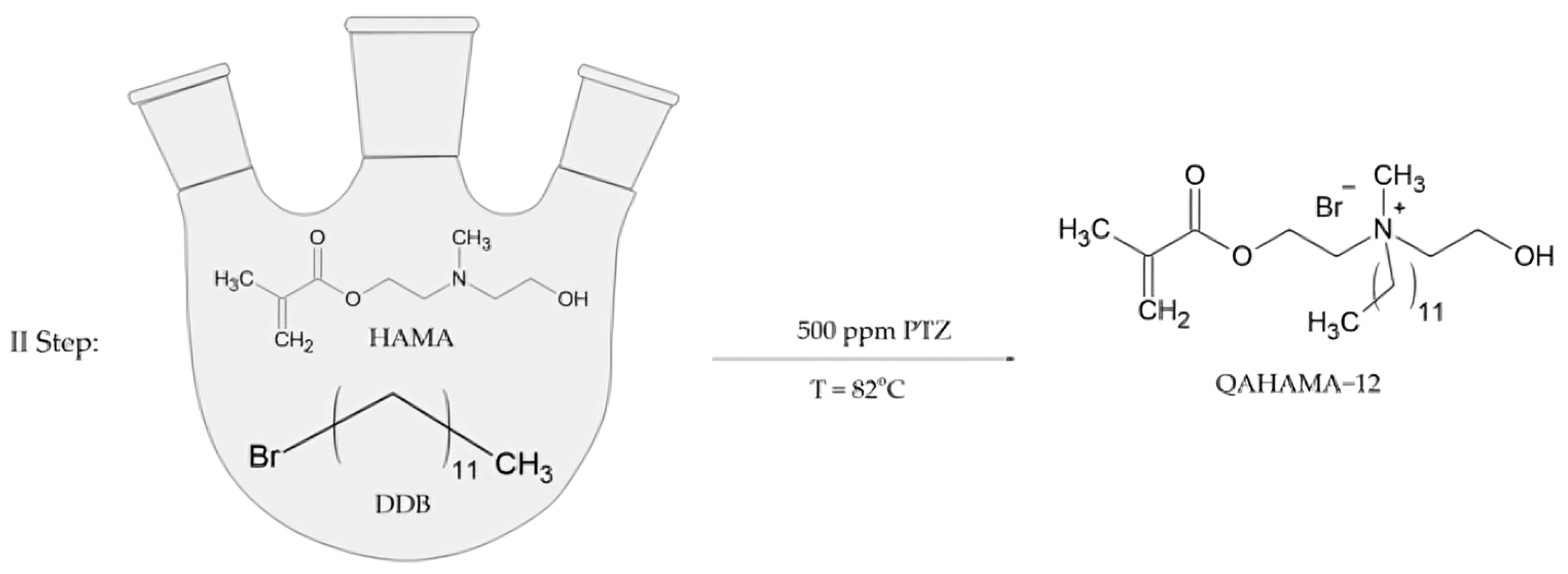
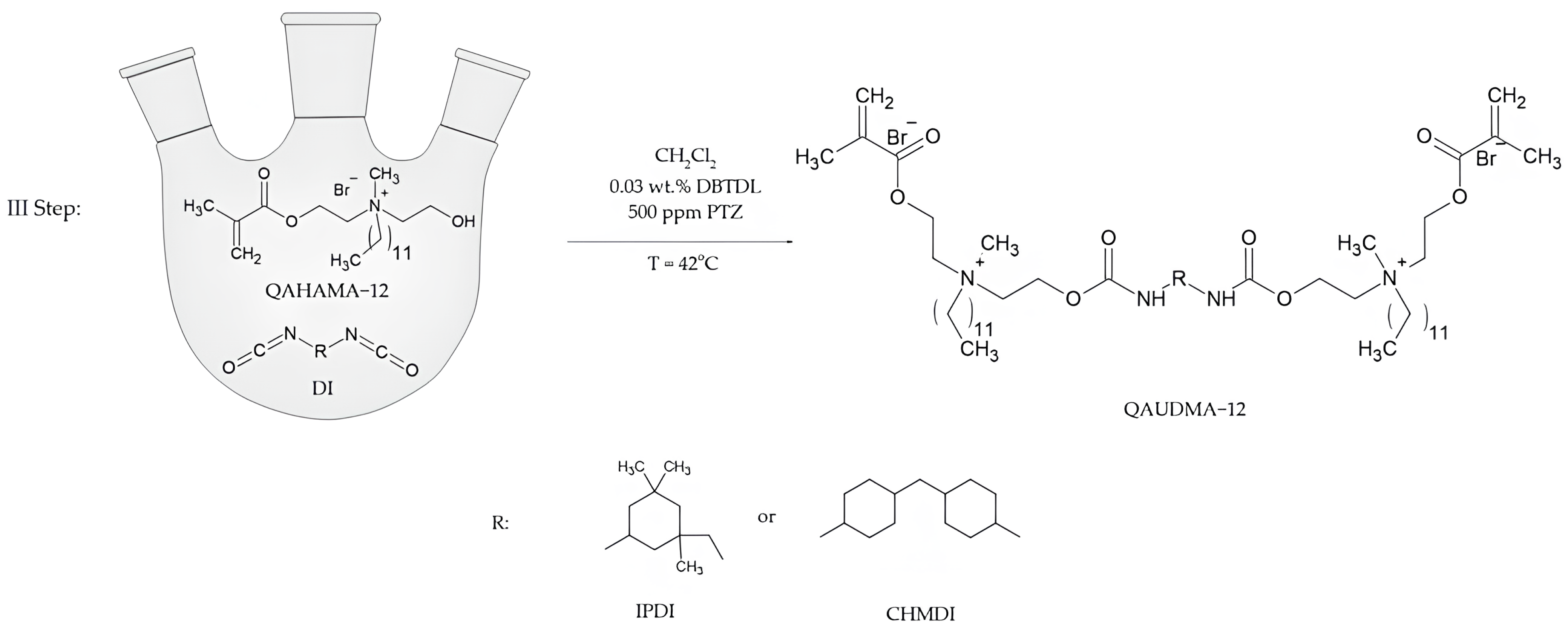
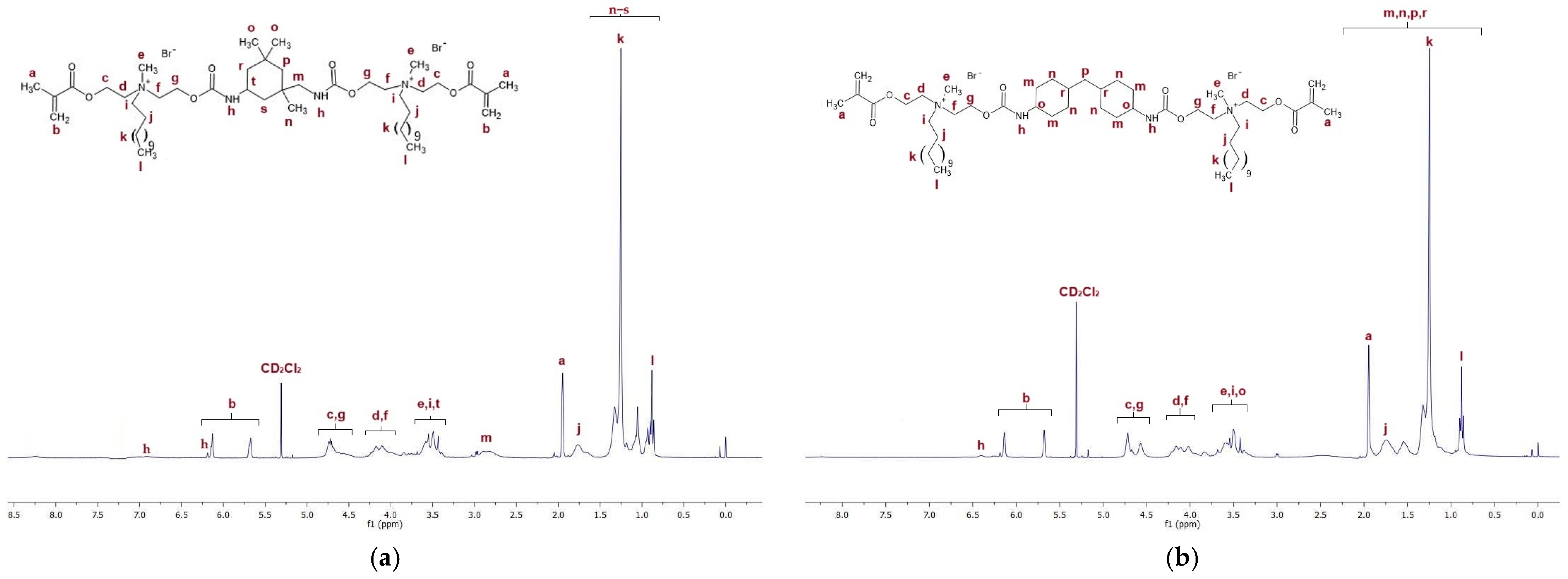
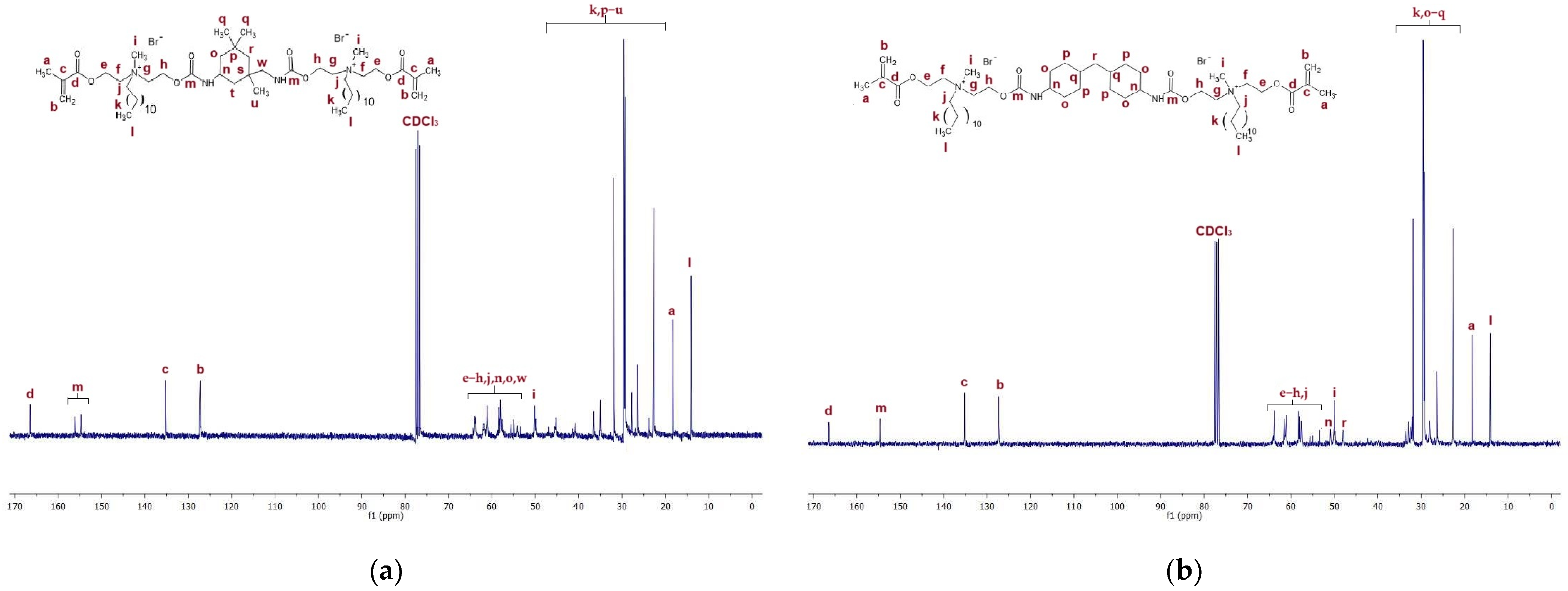

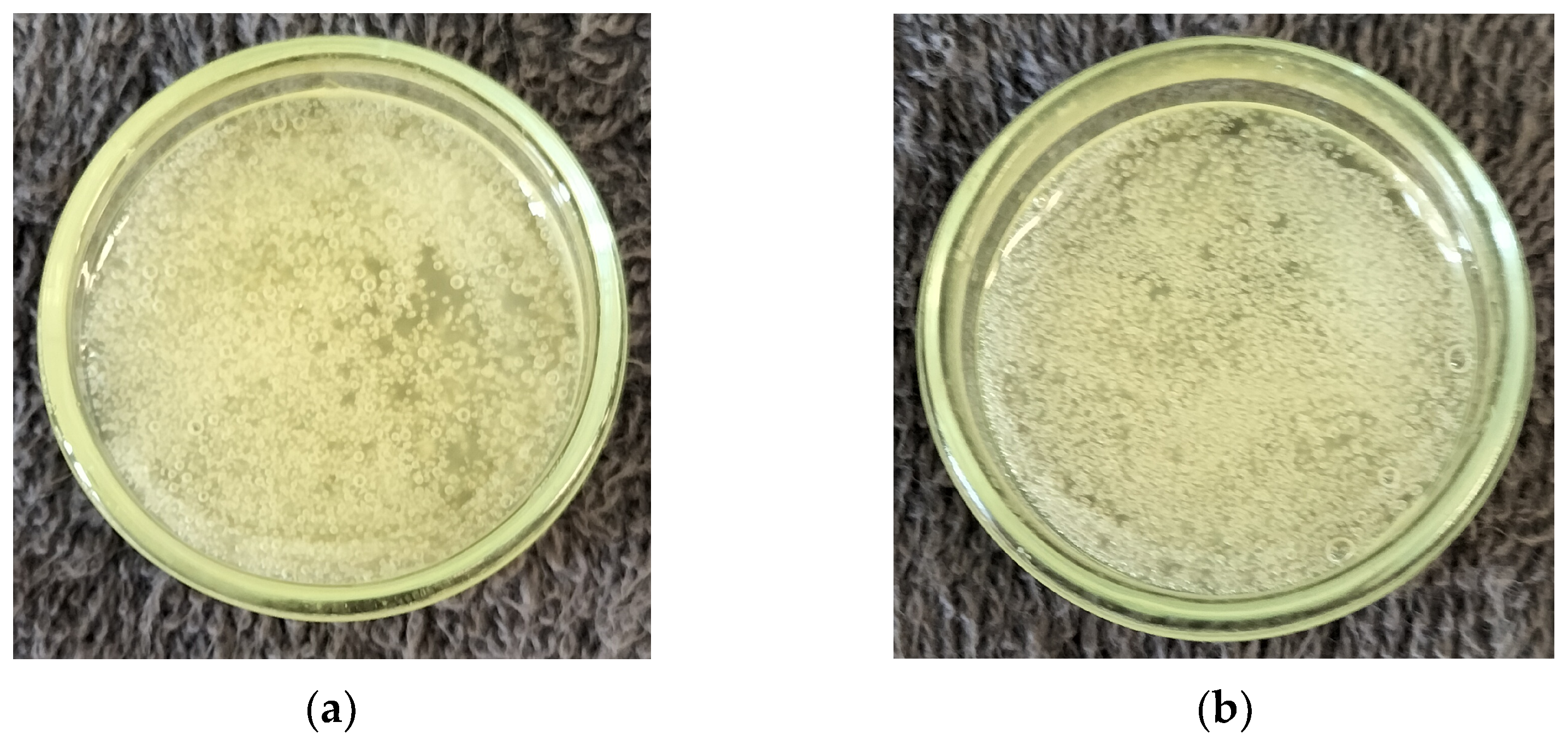
| Substance | Mass (g) | Moles (mol) |
|---|---|---|
| Substrates | ||
| MMA | 100.12 | 1.00 |
| MDEA | 79.85 | 0.67 |
| Transesterification catalyst | ||
| K2CO3 | 14.40 | 1 |
| Polymerization inhibitor | ||
| PTZ | 0.05 | 1 |
| Solvent | ||
| Toluene | 346 | 1 |
| Substance | Mass (g) | Moles (mol) |
|---|---|---|
| Substrates | ||
| HAMA | 20.00 | 0.107 |
| DDB | 26.67 | 0.107 |
| Polymerization inhibitor | ||
| PTZ | 0.01 | 1 |
| QAUDMA | Substance | Mass (g) | Moles (mol) |
|---|---|---|---|
| QA12 + IPDI | QAHAMA-12 | 20.34 | 0.047 |
| IPDI | 5.18 | 0.023 | |
| DBTDL | 0.008 | 1 | |
| QA12 + CHMDI | QAHAMA-12 | 22.82 | 0.052 |
| CHMDI | 6.86 | 0.026 | |
| DBTDL | 0.009 | 1 |
Disclaimer/Publisher’s Note: The statements, opinions and data contained in all publications are solely those of the individual author(s) and contributor(s) and not of MDPI and/or the editor(s). MDPI and/or the editor(s) disclaim responsibility for any injury to people or property resulting from any ideas, methods, instructions or products referred to in the content. |
© 2025 by the authors. Licensee MDPI, Basel, Switzerland. This article is an open access article distributed under the terms and conditions of the Creative Commons Attribution (CC BY) license (https://creativecommons.org/licenses/by/4.0/).
Share and Cite
Drejka, P.; Kula, P.; Barszczewska-Rybarek, I. Synthesis and Structural Characterization of Novel Urethane-Dimethacrylate Monomers with Two Quaternary Ammonium Groups Based on Cycloaliphatic Diisocyanates. Eng. Proc. 2025, 87, 20. https://doi.org/10.3390/engproc2025087020
Drejka P, Kula P, Barszczewska-Rybarek I. Synthesis and Structural Characterization of Novel Urethane-Dimethacrylate Monomers with Two Quaternary Ammonium Groups Based on Cycloaliphatic Diisocyanates. Engineering Proceedings. 2025; 87(1):20. https://doi.org/10.3390/engproc2025087020
Chicago/Turabian StyleDrejka, Patryk, Patrycja Kula, and Izabela Barszczewska-Rybarek. 2025. "Synthesis and Structural Characterization of Novel Urethane-Dimethacrylate Monomers with Two Quaternary Ammonium Groups Based on Cycloaliphatic Diisocyanates" Engineering Proceedings 87, no. 1: 20. https://doi.org/10.3390/engproc2025087020
APA StyleDrejka, P., Kula, P., & Barszczewska-Rybarek, I. (2025). Synthesis and Structural Characterization of Novel Urethane-Dimethacrylate Monomers with Two Quaternary Ammonium Groups Based on Cycloaliphatic Diisocyanates. Engineering Proceedings, 87(1), 20. https://doi.org/10.3390/engproc2025087020






